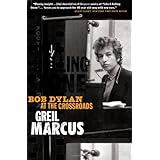
Average Reviews:

(More customer reviews)A whole book about one song? If there's a song that deserves it, it's Dylan's "Like a Rolling Stone," but this is Greil Marcus, and there's a lot of history, social context and cultural detritus here beyond the song, no surprise. The first section of the book is on the social context into which the song was launched, the middle section is about the making of the song itself, and the last section is about its reception and effects.
I found some of Marcus's cultural commentary compelling and some not so compelling -- the highlights for me are the less disputable "facts" about the great song itself, recorded on June 15, 1965 and released on July 24, 1965. It stormed the pop charts, unprecedented for a 6-minute song, and reached #2 in the USA. What was #1, you ask? It was the Beatles' "Help!" Al Kooper's story of how he ended up playing organ is quite amusing, and Dylan's recruitment and use of Michael Bloomfield in the session is fascinating. Also superb is Marcus's account of the ensuing tour of the new electric Dylan, with the booing in the U.S. and the large-scale disruption of the U.K. concerts, some of it quite purposefully organized by the old British Communist Party, as it turns out, which controlled a network of stodgy folk clubs. "Like a Rolling Stone" was the last song every night on that tour, a perfect howl of anger for Dylan to wreak vengeance on his recalcitrant fans. (See my 9/5/04 review of the LIVE 1966 disc, the official release of the famous "Royal Albert Hall" bootleg of the Manchester concert.)
Once you realize the scope of Marcus's musings, it becomes clear that this book could have been much longer. He never devotes any attention to the fact that the song was an existentialist anthem, for instance, which might have involved analysis of the existentialists and their influence on Dylan. He doesn't have much to say about the class resentment that drives much of the song's powerful angry energy, or the vast and growing inequality in the the U.S. that might make that resentment more and more relevant at 40 years on, as the old New Deal programs are under full-scale assault by the president and congress. Dylan himself said "I was hungry, and it was your world" ("Just Like a Woman"), he also said "Papa's bankbook wasn't big enough" ("Tangled Up In Blue"), both references to the fact that he, a middle class boy, had entered a higher status world, and experienced class resentment. Much could have been made of the social context of the Vietnam War, and Dylan's refusal to address it. The turn from the left-wing politics of his folk period (for civil rights, against war) to the apolitical, surrealist stance he took in 1964-5 is never seriously tackled. Some of Marcus's musings are quite idiosyncratic -- of all the music that has followed "Like a Rolling Stone" he chooses the Village People and the Pet Shop Boys for special treatment. I would have chosen at least a thousand others first, but there you go, it's a wide world for cultural influence, and there's 40 years to work with. He mentions, and includes the entire text of, a great old early '70s comedy skit that they used to play on WXRT in Chicago with Dylan pitching a K-Tel album of Golden Protest. An Italian rap group's version of The Song from MASKED AND ANONYMOUS is analyzed at some length.
I can now easily imagine books about Dylan's "Like a Rolling Stone" quite different from this one. But they haven't been written. I'll close with a quote from Dylan himself from 2004:
"It's like a ghost is writing a song like that. It gives you the song, and then it goes away, it goes away."
Click Here to see more reviews about: Like a Rolling Stone: Bob Dylan at the Crossroads
Click here for more information about Like a Rolling Stone: Bob Dylan at the Crossroads

0 comments:
Post a Comment